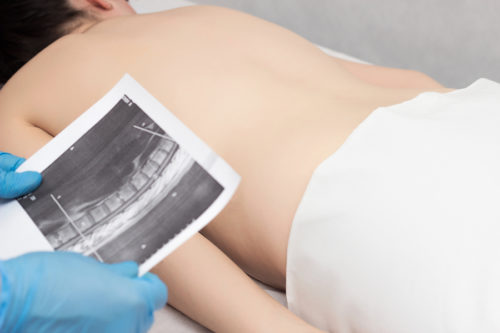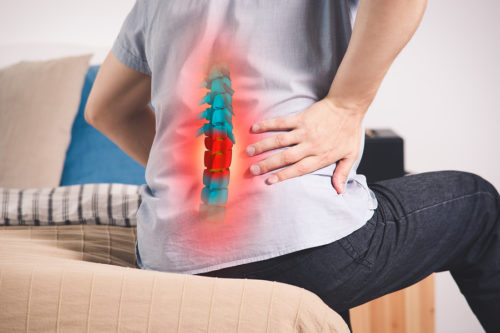Determining the Value of an Accident Back Injury
Did you know that back pain is the third most common reason for a visit to the doctor? In fact, the American Chiropractic Association estimates that approximately 80 percent of people will experience back pain at some point in their lives. Back pain affects people differently. For some, it’s a throbbing feeling that causes short-term, intermittent pain; for others, back pain is debilitating and can make it difficult to walk. Accidents happen every day. They happen at the store, at your home, and far too often, at work. Back pain is one of the leading complaints after an accident. If you have suffered a back injury because of an accident, you may be eligible for financial compensation. If you need help figuring out if you have a claim, contact a personal injury attorney.
A Closer Look at the Different Types of Back Injuries
The back provides support for our bodies. It is composed of bones, muscles, and nerves that allow us to stand, walk, and move. When we think about the back, we think about the spine. The spine runs from the base of the skull to just below the hips. Individual vertebrae surround the spinal cord, the body’s primary messenger system. Each of these vertebrae is cushioned by a round, gel-like disc. When it comes to back injuries, the injury can occur at the vertebrae, the cord, or the supporting muscles. Take a look at some of the most common back injuries:
- Herniated/bulging discs: The spinal discs are soft, gel-filled sacs that separate the vertebrae of the spine. Their primary purpose is to provide cushion and minimize injury. While they help prevent injury to the spine, they are quite vulnerable to injury themselves. During an accident, the force can cause the disc to rupture. A minor injury will result in a small bulge. If the bulge puts pressure on the nerve, sufferers may experience quite a deal of pain. A herniated disc occurs when the bulge becomes too big and causes fluid to leak out of the disc.
- Back strains: Back strains are usually minor injuries, but they can still cause a great deal of pain. A strain happens when the muscles or tendons stretch too far. When this happens, small tears can form in the muscle fibers, causing inflammation and pain. These injuries usually respond to physical therapy or pain relievers, but in some cases, surgery may be necessary.
- Whiplash: Whiplash is usually the result of a rear-end accident. When a car hits you from behind, the force of the collision causes the head to slap back and then “whip” forward. This causes a strain on the spine and surrounding muscles. Generally, whiplash results in nothing more than temporary soreness. However, more severe cases can include herniated or bulging discs.
- Spinal cord injuries: Spinal cord injuries are the most serious type of back injury. A spinal cord injury (SCI) happens when the cord sustains a hard blow or penetrating wound. The nerves relay messages from the brain to the rest of the body. When an injury to the spinal cord happens, it affects the body’s messenger system. Severe spinal cord injuries can result in permanent paralysis. The paralysis generally extends below the point of injury. With a complete SCI, the paralysis is even on both sides. Individuals with an incomplete SCI may retain some function on one side of the body.
Common Causes of Back Injuries
Back injuries happen every day. Often, these injuries are preventable and can happen because of improper lifting or strenuous activity. But many times, back injuries occur as a result of a preventable accident. When someone’s negligence is the cause of your injuries, you face a whole different set of challenges separate from your injury. The most common causes of back injuries are:
- Motor vehicle accidents: In 2018, there were over a quarter-million injuries caused by car accidents in Florida. After an accident, it’s always a good idea to seek medical treatment. In fact, to be eligible to use your PIP benefits, you must see a qualified doctor within 14 days of your accident. If you are experiencing back pain, the doctor may recommend an x-ray or MRI to determine the source of your pain.
- Workplace accidents: When it comes to on-the-job injuries, back injuries come in near the top of the list. These injuries can happen when the employee is lifting something heavy; pushing, pulling, or reaching; or because of a fall. While the employee has a responsibility to exercise safe work practices, the employer must provide all employees with a safe work environment, proper training, and appropriate equipment.
- Slip and fall accidents: Falls are dangerous. According to the Centers for Disease Control, over three-million people go to the emergency room each year because of fall injuries. Falls can happen because of a slippery or uneven surface. Injuries from slip and fall accidents can range from a minor backache to a disabling spinal cord injury.
- Medical malpractice: We rely on our doctors to fix our injuries. But sometimes, mistakes happen. Back injuries can occur when the hospital staff makes an error or does not take the necessary due diligence.
What Are My Back Injury Treatment Options?
 Many factors will determine the type and duration of your treatment after suffering a back injury. The most important variables are what type of injury you have sustained and the extent of the injury. For example, chiropractic treatment is a suitable course of treatment for whiplash, but not for a spinal cord injury. Some of the most common forms of treatment include:
Many factors will determine the type and duration of your treatment after suffering a back injury. The most important variables are what type of injury you have sustained and the extent of the injury. For example, chiropractic treatment is a suitable course of treatment for whiplash, but not for a spinal cord injury. Some of the most common forms of treatment include:
- Muscle relaxers/pain medication: Back injuries can be painful. Even strains can make you feel like you can’t get out of bed. For minor injuries, medication can help relax your muscles and reduce the pain. Often, medication can dramatically reduce your level of pain. They don’t address the underlying problem, however, and many are addictive or debilitating.
- Chiropractic treatment: Chiropractic treatment is often recommended after an auto accident. A chiropractor can realign your spine and help alleviate any pressure. The doctor may also use other forms of treatment, such as exercise tape, cold therapy, heat therapy, or electrical stimulation.
- Massage: A back injury can cause muscle soreness. A massage therapist can work on the muscles that support the back to help reduce tension. Check with your care provider to see if your PIP covers your massage treatment.
- Steroid injections: When alternative remedies don’t alleviate your back pain, your care provider may recommend steroid injections. During treatment, the doctor will use medical imaging to guide a needle into the space between your spine to inject a corticosteroid. The steroid may reduce inflammation and pain. Some patients may experience an immediate change in their symptoms, while others may see no effects at all.
- Surgery: Surgery is often the last resort when it comes to back issues. Doctors like to try less invasive methods first. However, if your pain does not go away with a less-aggressive approach, surgery may be the only option. There are several types of back surgeries, including spinal fusion and discectomies (disc removal).
How Much Is My Back Injury Claim Worth?
After an accident, it’s normal to think about money. In the face of mounting medical debt and car repair bills, it’s easy to get overwhelmed with how you are going to pay for it all. When it comes to determining how much your back injury is worth, there is no simple answer. The type of injury, the severity of injuries, and fault all come into play when calculating a final injury award. One of the primary factors that insurance companies will consider is costs, including economic damages and non-economic damages.
Economic damages
Economic damages are ones that have a direct cost. These are costs that you can assume will stay relatively consistent across any case, including:
- Medical bills: Medical bills can add up quickly. In a personal injury case, medical bills are usually covered dollar for dollar. Common costs include doctor visits, medications, injections, physical therapy, surgeries, and chiropractic treatment.
- Lost wages: According to the ACA, back pain results in over 264 million missed days at work. For many people, missing just one day at work can have a serious impact on your finances. Missing multiple days can be catastrophic. Lost wages help cover lost income from the time of your injury to the time that you can return to work.
- Home modifications: Spinal cord injuries can result in paralysis. When this happens, you will need to rely on a wheelchair to help you get around. This will likely mean you will need to make modifications to your home, including ramps, lifts, and other modifications.
Non-economic damages
Non-economic damages vary from person to person. It’s not easy to put an exact dollar amount on these costs. Typical damages include:
- Pain and suffering: Pain and suffering is a broad term used to describe the physical, mental, and emotional pain of an injury. While economic damages compensate you for the cost of your actual treatment, they do not take into account the physical and emotional effect that your injury has had on your wellbeing. These costs will depend on the specific circumstances of your case, but usually include physical pain and mental health issues, such as depression, anxiety, and PTSD.
- Loss of enjoyment: Most people take the simple pleasures in life for granted. The ability to walk their dogs, cook for their children, or play pickup games of basketball. When an injury makes these activities impossible, it can be hard for the injured individual to comprehend. A personal injury claim will consider your previous activities and whether your injury has had an adverse effect on your happiness and quality of life.
- Loss of consortium: In a relationship, we depend on others to provide certain things. In a parent-child relationship, it’s love, companionship, and guidance. In a spousal relationship, it’s friendship, companionship, and a sexual relationship. When an injury changes a person’s ability to contribute to a relationship in the same way that they were previously able to, the family may have a claim for loss of consortium.
Who Pays for My Back Injuries?
Who exactly pays for the costs associated with an accident? Several parties may come into play. Who covers certain costs will ultimately come down to who’s at fault. Depending on the circumstances, payment may come from the following sources:
- Your auto insurance: Florida law requires all drivers to carry a $10,000 personal injury protection (PIP) policy. In the event of a car accident, your PIP coverage will cover the first $10,000 in medical costs and lost wages, regardless of who is at fault. There is a 20 percent copay, but these costs are generally recovered at the end of a personal injury case.
- Your medical insurance: If you have personal medical insurance, a personal injury claim does not preclude you from using your own medical insurance. Before filing a personal injury claim, your personal medical coverage can help you get the care that you need.
- Your employer: If you were injured at work, you may have a claim for worker’s compensation. If this is the case, your employer will be responsible for all costs associated with your injury.
- The at-fault party: If your injury was caused by someone else’s negligence, they may hold financial responsibility for your costs. A personal injury attorney can help you prove fault and help you with your personal injury claim. If you use your PIP coverage or personal medical insurance, these providers may have a claim to recover any payments they made from the at-fault party, as well.
A back injury can have a tremendous effect on your life. Knowing that you will have the financial means to take care of your injuries can help you focus on your recovery. If you have been injured because of someone else’s negligence, take your injuries seriously. Don’t put off treatment because of the fear of costs. If you have questions about a recent accident or need help coordinating your care, contact a Florida personal injury attorney for more information. Dolman Law Group Accident Injury Lawyers, PA 800 North Belcher Road Clearwater, FL 33765 (727) 451-6900 https://www.dolmanlaw.com/florida-personal-injury-lawyer/






